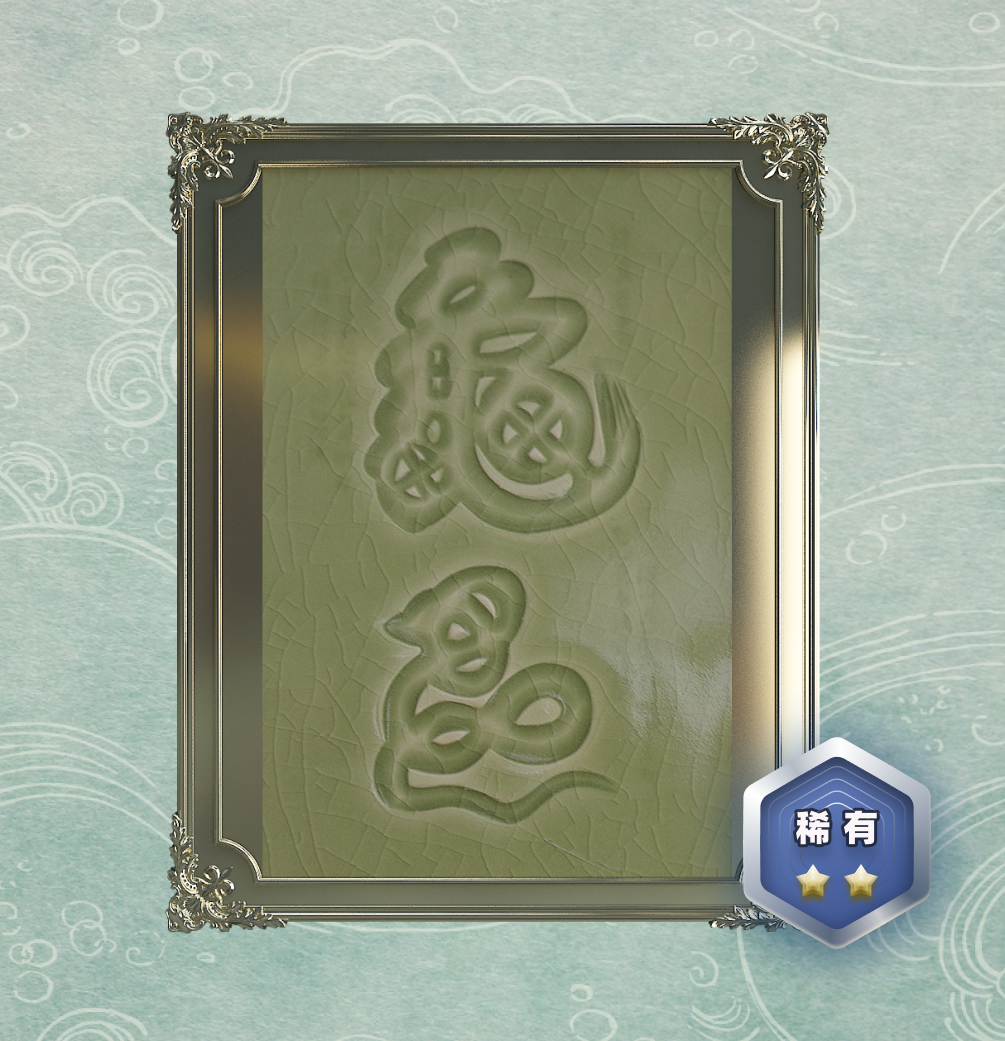
Yaozhou porcelain series
Name: Turtle and snake pendant
Category: Porcelain
Size: 22*30CM
Meaning: ward off evil, auspiciousness, riches
Offering Information
Sale platform: Star Revelation Collection
Collection Level: Rare
Introduction to the collection
The inscription of the turtle and snake pendant comes from the turtle and snake stone stele of Yaowang Mountain in Tongchuan, Shaanxi, which is a rare stele treasure in the country. Its Tuoben is also a unique calligraphy artifact. The word "turtle" is like a turtle crawling upwards, and the word "snake" is like a long snake with a vine coiled around it, vivid and vivid, and it is waved. The work adopts the decorative technique of engraving flowers and applies a highly textured blue glaze of glass, and vividly conveys the vivid expression of the word "turtle and snake" in the art form, the penmanship is vigorous, and the flowing flow is vividly displayed on the porcelain plate. The "Turtle and Snake" stele is a product of Taoism, which has the meaning of "revering the right and eliminating evil" and "warding off evil in the town house", so this work also has this meaning as a pendant.
Collection appreciation
Xuanwu is a kind of beast combined with turtles and snakes, "turtle" is a symbol of perseverance, perseverance and wealth in the traditional culture of the mainland, and "snake" in ancient China means gods, dragons, wealth and auspiciousness, which is a very auspicious symbol.
"Turtle and snake" is one of the "four elephants", also known as "four spirits", symbolizing peace and wealth, longevity and happiness, and also means that society can present a prosperous scene.
Introduction of Yaozhou porcelain
Yaozhou porcelain comes from Tongchuan, Shaanxi, and is named after the Fact that Tongchuan was under the jurisdiction of Yaozhou Prefecture during the Song Dynasty. Yaozhou kiln is a representative of celadon porcelain in northern China.
Tongchuan Yaozhou Kiln LiJia Porcelain Workshop is a porcelain-making workshop that inherits the thousand-year-old furnace fire technique, and is a new generation of Yao porcelain production entity founded in 1992 by its descendants Li Shengke and daughter Li Zhuling on the basis of the century-old "Li Family on the Bridge" porcelain workshop in Chen Lu Town.
Li Shengke loved to make ceramic porcelain from an early age, starting from the "urn kiln", pulling a billet by hand, after years of practice and research, he became a famous teacher of yao porcelain; Daughter Li Zhuling learned art from her father from an early age, and was known for her carving and decoration, and went to Xi'an, Guangdong, Beijing and other places to study, visiting famous teachers. Due to their outstanding achievements, the father and daughter became masters of arts and crafts in Shaanxi, China at the same time.
Since its inception, Lijia Porcelain Factory has not only paid attention to the inheritance of traditional Yao porcelain culture, but also committed to the innovation and dissemination of Yao porcelain technology. On the basis of Lijia Porcelain Factory developed by Tongchuan Yaozhou Kiln Lijia Porcelain Factory Co., Ltd., in the production and production, both attach importance to traditional skills, but also constantly innovate the process, after more than ten years of development, has formed a traditional boutique, modern products and ceramics as the main body of the production pattern, especially black glazed porcelain, blue glaze carved porcelain is the most distinctive. The works are simple and exquisite, the shape is unique, the knife work is sharp, the glaze color is moist, the overall style is stretched generously, the art is elegant, the sense of the times is strong, and it is creative.
Li Jia Porcelain Factory is a veritable and loyal evangelist of Yaozhou porcelain today. Lijia Porcelain Factory has continuously increased foreign exchanges, widely received Chinese and foreign friends and university teachers and students to visit and create, and has become a scientific research practice base for famous college students.
Teacher Li Zhuling introduced
Teacher Li Zhuling
Teacher Li Zhuling is a master of Chinese arts and crafts, a master of Chinese ceramic design art, a senior arts and crafts artist, and is currently the general manager of Tongchuan Yaozhou Kiln Lijia Porcelain Factory Co., Ltd. She comes from a family of Chen furnace ceramics and is the inheritor of Yaozhou porcelain. In 1986, he entered the porcelain industry to learn art, and in the past 30 years, he has been slashing and plowing, and on the basis of inheriting traditional decorative technology, he has gradually formed his own technical characteristics and style.
Her works are sharp and round, the lines are lively and smooth, the layout is reasonable and precise, the picture is layered, and the natural beauty of harmony between modeling, decoration and glaze color is pursued. His works have won many gold and silver medals for ceramics exhibitions and international art expositions organized by the China Academy of Arts, the China Arts and Crafts Art Museum, the China Arts and Crafts Society, and the China Ceramics Association, and are widely loved and collected by people at home and abroad.
Issuer Introduction
Xingqi Digital Collection is a professional digital cultural art collection platform integrating intangible cultural heritage, cultural creation, cultural and tourism, etc., with the underlying protocol of the BSN blockchain as the infrastructure, the IP rights confirmation and transaction algorithm as the core, and the NFT casting and distribution as the basis, empowering culture and art through the digital economy, and realizing the casting, distribution, purchase, collection and dissemination of the collection chain.